It’s easy to appreciate the night sky’s beauty without fancy equipment. Just step outside for 5 minutes and look around. About 45 minutes after sunset this month, brilliant Venus rides above the deepening orange twilight in the southwest. Mean-while, the twinkling white star Fomalhaut breaks the quiet of the southern horizon, and the ruddy luster of Mars commands your gaze to the east.
Pop outside again around 9 P.M. local time to see Mars standing high in the south and winter’s sparkling stars dominating the east.
Winter boasts more bright stars than any other season. Look to the east and you’ll find reddish Betelgeuse and blue-white Rigel ruling Orion the Hunter. Gleaming Sirius and yellowish Procyon lie below Orion, while ruddy Aldebaran and golden Capella stand above.
The bright “star” low in the east won’t be twinkling, however, a telltale sign it’s really a planet. The pale, yellowish hue identifies it as Saturn. With binoculars, you can find the asteroid Vesta crawling through the star fields of Gemini.
As darkness starts to fall, focus on Venus. This cloud-covered world hits greatest brilliancy December 9, when it gleams at magnitude –4.6. Through a telescope, its beautiful crescent shape will delight all viewers. Venus is now approaching Earth rapidly, and as it does so, its telescopic appearance undergoes great change. Venus’ disk swells more than 50 percent during December, while its phase thins from one-third lit to less than 10-percent illumination. At midmonth, Venus appears 3 times bigger than Mars.
After you zero in on Venus, take a look at Mars. Although now past its peak, Mars appears bigger and brighter in early December than it will at any time in the next 10 years. Through a telescope, the fourth planet is a study in fleeting detail and low-contrast surface markings that reward patient observers. Avoid looking over rooftops, where escaping heat will blur the image. Persistence and practice are the keys to observing the Red Planet.
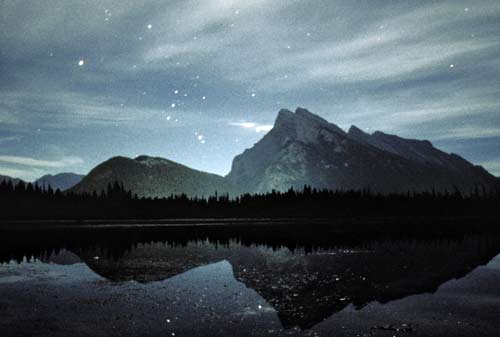
Orion rises over Mt. Rundle in the Canadian Rockies. The Hunter’s return to the evening sky announces winter’s arrival.
Alan Dyer
The crown jewel of the night sky is the ringed wonder, Saturn. Wait until late evening — once it has climbed above the worst of the low-level turbulence in Earth’s atmosphere — to observe it. The planet’s rings have closed quite a bit since spring. They’ll appear edge-on in less than 4 years.
The Moon, new on December 1, makes a dramatic return to the evening sky when it pairs up with Venus on the 4th. Your eyes alone will give a great view, but use binoculars to best see earthshine, the ashen glow on the Moon’s dark side caused by sunlight reflecting off Earth. Each day thereafter, earthshine gets harder to see as more of the Moon’s visible hemisphere receives direct sunlight.
On December 11, the waxing Moon slices past Mars. If you have a digital camera, try your hand at a series of exposures to show the Moon’s motion relative to Mars. The Moon moves the distance of its own diameter every hour.
The growing Moon plays havoc with this year’s Geminid meteor shower. The annual shower peaks Tuesday night, December 13/14, just 1 day before Full Moon. Still, Geminid meteors are the year’s brightest, so you should see up to 10 per hour if you view from a city backyard. You’ll get better results (and have more fun) if you observe with friends away from the city.
Early risers can catch innermost Mercury as it puts on its best show of 2005. Look southeast around 6 A.M. local time, to the lower left of brilliant Jupiter. In the first few days of December, you’ll need binoculars to spot the peach-colored dot. By the second week, it will be an obvious starlike point flickering through Earth’s turbulent lower atmosphere.
The deep sky
The Demon Star Algol winks at us during the height of the Geminid meteor shower. To see a collection of non-shooting stars, visit Perseus’ grand cluster, M34.
Fading on cue
Known to the ancients for its odd behavior, the Demon Star Algol in the constellation Perseus dims by 70 percent during the course of a few hours, then recovers as if nothing happened. When English amateur astron-omer John Goodricke put it under close scrutiny in the 1780s, he lifted Algol’s veil of mystery. Goodricke even suggested — correctly, it turns out — the clockwork variations are caused by a fainter star eclipsing a brighter one. Once each orbit of this eclipsing binary system, the dim companion passes between the main star and Earth, blocking most of the bright star from view.
By cosmic coincidence, Algol will dim while Geminid meteors fly. Algol begins the night of December 13/14 at its normal brightness of magnitude 2.1. It starts fading by 11 P.M. EST and reaches minimum brightness (magnitude 3.4) about 1:20 A.M. EST. It then brightens just as quickly, returning to near normal during the next 2 hours. Although Algol takes nearly 10 hours to complete an eclipse, most of the brightness change happens in the middle 4 hours.
The Demon Star’s next act will be easier for evening observers to follow. It takes place between approximately 8 P.M. and midnight EST December 16, with minimum occurring at 10:09 P.M.
One way to remember which star is Algol, is to imagine it as the end of the handle in a “Giant Dipper” asterism. In this view, the Great Square of Pegasus serves as the bowl and Andromeda’s southern string of stars forms the rest of the handle. Algol normally shines as bright as any of them, but at its dimmest, it is easily the faintest of the lot.
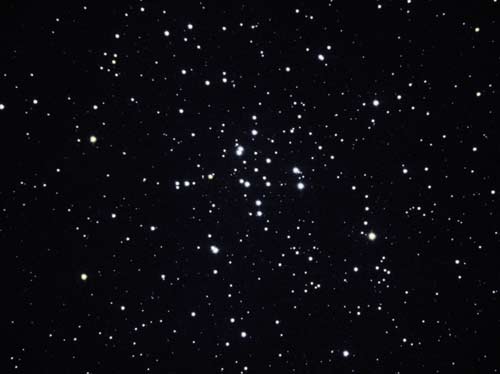
Glittering star clusters M34 lies on the outskirts of the Milky Way. You can spot it with the naked eye under a dark sky.
Jack Newton
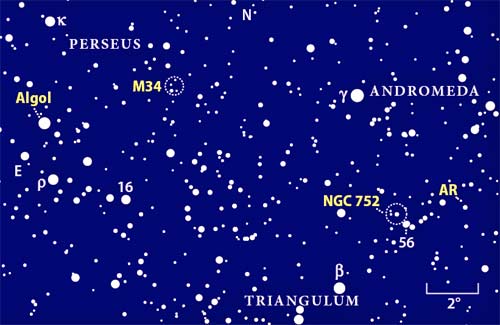
The hero Perseus rides the Milky Way, giving it a complement of bright star clusters as well as a famous variable star, Angol.
Astronomy: Roen Kelly
City clusters
It’s pretty tough for the diffuse light of a distant galaxy or nearby comet to shine through the skyglow that pervades most populated areas. Not so with star clusters. These collections of stellar pinpoints penetrate the veil with relative ease.
The 34th entry in Charles Messier’s catalog of clusters and nebulae proves the point. Look for it near the end of our imaginary dipper’s handle. From a city backyard, binoculars will show you M34 clearly; a telescope, with its higher magnification, frames it nicely.
A much different cluster, NGC 752, lies not far away in Andromeda. Slightly bigger than M34, NGC 752 comprises stars mostly of the same brightness. Just off the cluster’s southwestern edge lies a wide pair of orange stars cataloged as 56 Andromedae. These stars are foreground objects unrelated to the cluster. If you’re away from the city, NGC 752 shows up nicely in binoculars.
City clusters
A short, 2.5° hop west from NGC 752 will land you on the unpredictable variable star AR Andromedae. When you first look for it, you may see an 11th-magnitude star — or nothing at all. In its quiescent phase, AR And simmers at 17th magnitude, slowly pulling gas from its faint, bloated companion star. After 15 or 20 days, enough fuel builds up to create a runaway thermonuclear explosion, catapulting the system’s brightness more than a hundredfold for a few nights. Astronomers call such stars cataclysmic variables.
The planets
Venus dazzles viewers around the world from its perch low in the early evening sky, while Mars and Saturn remain prominent nearly the whole night through.
Shining brilliantly in the southwestern sky after sunset, Venus will immediately grab your attention. It reaches greatest brilliancy December 9, when it gleams at magnitude –4.6, but it remains the brightest point of light in the sky all month.
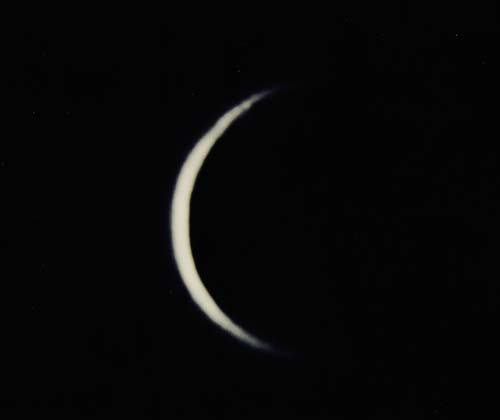
A big, crescent Venus greets anyone who aims a telescope at the brilliant planet this month.
David Brewer
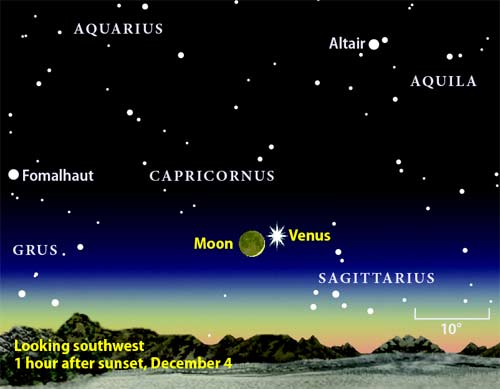
Venus appears brightest during December, but the highligh of its month comes when the Moon scoots by on the 4th.
Astronomy: Roen Kelly
Venus’ appearance through a telescope shows a remarkable range this month. On the 1st, the planet appears 36″ across and 33-percent lit. By New Year’s Eve, it measures 57″ across and shows a 7-percent-lit phase. It shouldn’t take you long to realize Venus’ orbital motion is bringing the planet closer to us while its sunlit hemisphere rotates away.
Don’t miss the view December 4, when a crescent Moon stands 4° to Venus’ left. The Moon then appears 15-percent lit, about half the planet’s illumination. Try this trick to compare the two crescents directly: With your right eye, view Venus through a scope; at the same time try to view the Moon with your left eye. This will work only with a refractor or small Schmidt-Cassegrain telescope, where you view along the direction the instrument points.
Before turning your gaze to Mars, the next brightest planet in the sky, take a few minutes to hunt down Neptune and Uranus before they disappear. Neptune glows at magnitude 8.0, bright enough to see through binoculars. It lies near the 4th-magnitude star Theta (θ) Capricorni. Try to catch the planet in early December. By the end of the month, it will be hard to pick out through the early evening haze.
Uranus lies higher in the sky than Neptune, among the background stars of Aquarius. At magnitude 5.9, it’s an easy target through binoculars. You’ll find it about halfway along an imaginary line joining Sigma (σ) and Lambda (λ) Aquarii. Look for it early in the evening — haze near the horizon will render it invisible well before its 10 P.M. setting time.
Let’s turn now to Mars. The Red Planet remains high on the observing list this month even as it continues to fade and shrink. On December 1, it shines at magnitude –1.6, still brighter than the brightest star in the sky, Sirius. It dims a full magnitude during the course of the month.
Through a telescope, the best views will come in the first half of December, when the planet’s disk spans 15″ or more. By month’s end, its apparent diameter is down to 12″, making it harder to see fine surface detail through small scopes. Mars stands high in the southeast after darkness falls, placed perfectly for early evening observers. Its high altitude yields crisp views because the planet’s light doesn’t have to travel through as much of Earth’s turbulent atmosphere.
As soon as darkness falls December 1, the Red Planet’s most prominent dark feature, Syrtis Major, lies centered on the martian disk. Because Mars takes about 40 minutes longer to rotate than Earth does, if you view at the same time from one night to the next, specific martian features appear slightly farther east. By December 7, Syrtis Major is just coming around the planet’s eastern limb as the sky grows dark. During the first 3 hours of darkness, this dark feature rotates into view and returns to the disk’s center once again.
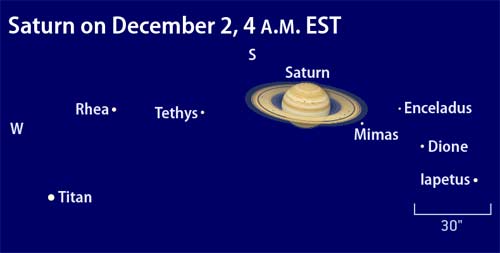
Saturn’s bright moons all gather near the planet during the early morning hours of December 2.
Astronomy: Roen Kelly
By mid-December, Mare Sirenum lies at the center of the martian globe in the early evening. Late in the month, Solis Lacus, the dark feature known as the “Eye of Mars,” stands front and center in the early evening hours. In addition to Mars’ light and dark surface markings, look for a less-than-full phase by month’s end. On New Year’s Eve, the planet’s disk appears 92-percent illuminated and noticeably out-of-round.
You don’t need a telescope to watch Mars move across the sky. Or, more precisely, to see it stop moving. On December 10, Mars’ retrograde motion comes to a halt, and it resumes its eastward trek relative to the stars of Aries the Ram.
Soon after darkness falls, Saturn puts on a nice display. By 11 P.M. local time December 1, it stands 20° high in the east. At the end of the month, you’ll find it well clear of the horizon by 9 P.M. local time. The ringed planet brightens throughout December, reaching magnitude –0.1 at year’s end. It lies among the faint background stars of Cancer the Crab. A quick binocular scan of this region will reveal the eye-catching Beehive star cluster (M44) northwest of Saturn. A waning gibbous Moon passes 4° north of the planet December 18.
Saturn ranks among the best telescopic sights in the sky. The rings show up nicely in any scope. Most viewers can spot the Cassini Division, the dark gap that separates the outer A ring from the brighter B ring. This month, the rings span 45″. The planet’s globe measures 20″ across, although few features are visible in its haze-laden atmosphere. The view of Saturn improves as it climbs higher in the sky after midnight. Its light then passes through less of our atmosphere, so you can use higher magnifications with greater success.
Tracking the motions of Saturn’s moons can keep you entertained almost every night. Each scoots around the planet with a different period. Occasionally, this brings about curious alignments.
A good example comes December 1 and 2, when all the planet’s bright moons cluster near Saturn’s disk. This includes Titan and Iapetus, two moons that spend most of their time far from the planet. Through a telescope, 8th-magnitude Titan appears brightest. Iapetus is more intriguing visually, however, because it has a dual personality. When it lies west of the planet, Iapetus shows us its brighter face, glowing at 10th magnitude. The moon appears 2 magnitudes fainter when it’s east of Saturn and its dark side faces us. Iapetus grows brighter through most of December, as it moves toward western elongation on the 22nd.
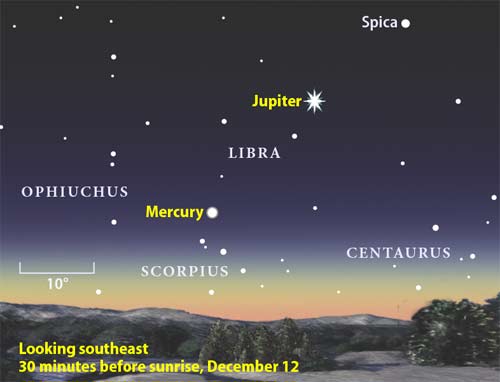
Mercury’s best appearance of the year comes in December’s morning sky. use brilliant Jupiter as a guide to the inner planet.
Astronomy: Roen Kelly
Giant Jupiter appears conspicuous shortly before dawn. It shines at magnitude –1.8, making it the brightest object by far in the eastern sky. Jupiter spends all month among the stars of Libra the Scales, edging closer to that constellation’s brightest star, Zubenelgenubi. On the 31st, Jupiter lies 2° northwest of the star.
Small telescopes will show Jupiter’s four bright moons: Io, Europa, Ganymede, and Callisto. You’ll probably want to wait a month to get a good view of the planet’s disk, however. Jupiter will then stand higher in the sky as twilight begins.
Mercury makes its best appearance of the year in December’s morning sky. When it reaches greatest western elongation December 12, the planet rises nearly 2 hours before the Sun and stands 12° above the southeastern horizon 30 minutes before sunrise.
You can spot Mercury to the lower left of Jupiter. How far below depends on when you look. At greatest elongation, the innermost planet lies at half Jupiter’s elevation half an hour before sunrise. On December 20, Mercury passes 6° north of Antares. At magnitude –0.6, Mercury appears much brighter than the 1st-magnitude star.
about:blank
Through a telescope, the small planet puts on a good show during December. It begins the month sporting a 9.0″-diameter disk that’s just 16-percent lit. At greatest elongation, it appears 6.6″ across and 63-percent illuminated. By month’s end, the planet’s disk is down to 5.1″ in diameter and the phase is up to 91-percent lit.
A Christmas gift greets early risers December 25, when the Moon hides the bright star Spica from view. This lunar occultation takes place during twilight for observers northeast of a line that stretches from Seattle to near Texas’ border with Mexico. Observers southwest of this line won’t witness an occultation, but they will see a pretty scene with the Moon passing just above the star. The event takes place in daylight for most observers. To find the exact time of the event for your location, visit www.lunar-occultations.com.
The winter solstice occurs December 21 at 1:35 P.M. EST. This marks the moment when the Sun lies at its farthest point south of the celestial equator, and the Northern Hemisphere experiences its shortest day.
Meteors and moons
The month’s two best meteor showers battle a bright Moon, but observers should still give the Geminids and Ursids a chance to shine.
about:blank
A not-so-sparkling gem
One of the best annual meteor showers won’t live up to its billing this year. The Geminid shower reaches its peak the night of December 13/14 — just 1 day before Full Moon. The Moon’s bright glow will wash out fainter meteors, leaving observers to see just the bright ones.
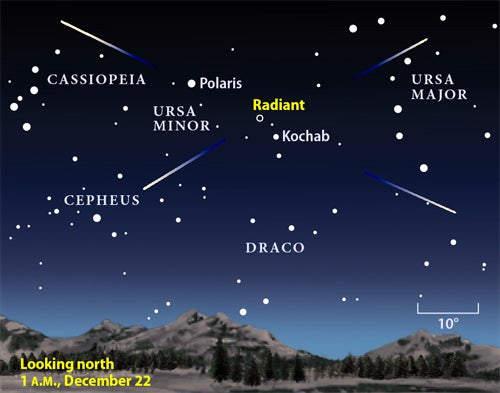
The Ursid shower peaks December 22, but a waning gibbous Moon will reduce the number of shooting stars visible.
Astronomy: Roen Kelly
Fortunately, this shower can stand the interference better than most. Geminid meteors tend to be bright, so a higher percentage will shine through the Moon’s unwanted glow. And more Geminids show color than any other shower except the Perseids. Expect to see about 10 meteors per hour from a city or suburban location, more if you’re out in the country. The meteors appear to radiate from the constellation Gemini, but they can blaze across any part of the sky.
One trick to try: Position yourself with your back to the Moon and a building or tree blocking the Moon’s disk. This will make your sky appear darker and yield more meteor sightings. And as with any extended observing this time of year, dress warmly and in layers. If you get cold, head inside for 10 minutes and grab some hot coffee or tea.
The Bear’s shower
about:blank
The Moon also interferes with December’s second meteor shower, although not as badly. The Ursid shower peaks the morning of December 22, when a waning gibbous Moon lights up the sky. The radiant lies near the bright star Kochab (Beta [β] Ursae Minoris), which appears below Polaris in the evening and above it before dawn.
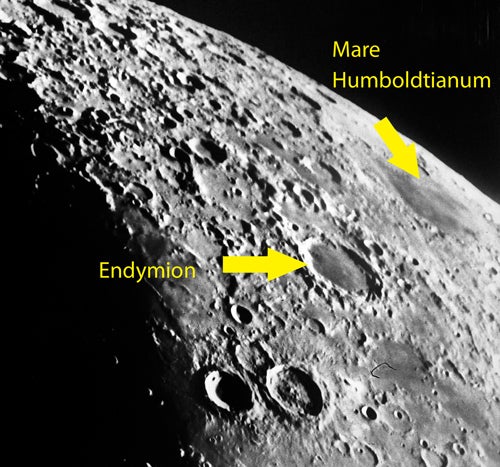
Lunar crater Endymion lies near the Moon’s northeastern limb, where it comes into prominence a few days after New Moon.
Consolidated Lunar Atlas (LPI/UA)

Lunar crater Endymion lies near the Moon’s northeastern limb, where it comes into prominence a few days after New Moon.
Consolidated Lunar Atlas (LPI/UA)
If 2005 is a typical year, count yourself lucky if you spot more than 5 meteors per hour. Ursid outbursts have occurred, however, so it may pay to watch. In 1988, 1994, and 2000, peak rates reached at least 3 times normal.
A shepherd’s crater
Shortly after the crescent Moon appears in the evening sky, the crater Endymion becomes visible near the northeastern limb. Named for a beautiful young shepherd in Greek legend, Endymion lies between the lunar limb and a prominent crater pair, Atlas and Hercules, beyond the eastern shore of Mare Frigoris.
Endymion is a large crater measuring 77 miles across. Its floor appears smooth and dark, with a few bright patches. The crater’s walls, highest on the northern side, reach more than 2 miles above the floor.
about:blank
The Moon’s northeastern limb shows up best in early December, from around the 3rd to the 8th. A favorable libration enhances the view by tilting this region slightly in our direction. This makes a good time to look for Mare Humboldtianum, an elusive dark expanse even closer to the limb.
Comets and asteroids
Asteroid Vesta cruises past the Eskimo Nebula and two bright stars this month. You’ll need more patience and a darker sky to spot Comet C/2005 E2 (McNaught).
Vesta rocks
December offers an exceptional opportunity to find an interplanetary rock. Not only is 4 Vesta the brightest asteroid in the sky, it also crosses the bright star fields of Gemini the Twins, which provide plenty of visual clues to help you track down this minor planet.
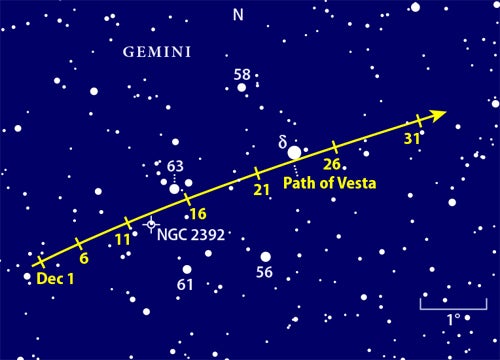
Asteroid 4 Vesta glows at 7th magnitude among the background stars of Gemini the Twins. Watch it pass the Eskimo Nebula (NGC 2392) December 12.
Astronomy: Roen Kelly
Head outside after 8 P.M. or so, and look to the east to find Castor and Pollux, Gemini’s two brightest stars. In early December, Vesta lies almost halfway from Castor (the northernmost member of the pair) to the bright yellow star Procyon in Canis Minor. At month’s end, the asteroid appears nearly one-third of the way from Pollux to Orion’s ruddy luminary, Betelgeuse.
Vesta glows at 7th magnitude this month, bright enough to see it through binoculars even from the suburbs. Only a handful of background stars in this part of Gemini have a similar brightness, so picking out the 320-mile-wide rock should be easy.
about:blank
Vesta has a few close calls with more distant objects this month, which should make finding it even easier. On December 13, the asteroid sails 11′ (one-third the Moon’s apparent diameter) north of the Eskimo Nebula (NGC 2392). This 9th-magnitude planetary nebula makes a fitting companion for a cold December night. Two nights later, Vesta tracks 12′ south of the 5.2-magnitude star 63 Geminorum. And finally, December 24, the asteroid skims 6′ south of the 3.5-magnitude star Delta (δ) Gem.
At the start of the 19th century, astronomers discovered asteroids by noticing a star out of place among the cataloged ones. In the days before cameras and computers, this was a tough slog. German astronomer Heinrich Olbers first sighted Vesta, the fourth minor planet, March 29, 1807; the 5th asteroid wasn’t found until 1845.
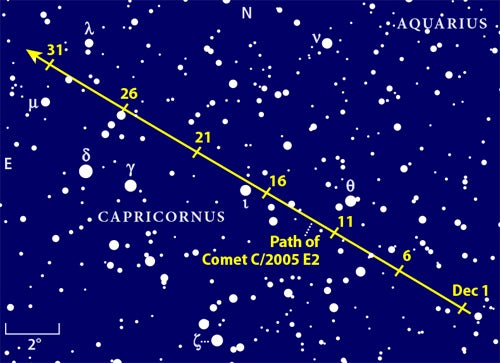
Comet C/2005 E2 (McNaught) should glow around 10th magnitude this month as it slowly tracks northeastward across the zodiacal constellation Capricornus
Astronomy: Roen Kelly
Catch Comet McNaught
In comparison with asteroids, moderately bright comets were easy to find in the 19th century. Their large, diffuse shapes and relatively fast motion were a dead giveaway to astronomers unburdened by the light pollution we face today.
You can test your observing skills by shooting for a 10th-magnitude comet, C/2005 E2 (McNaught). It lies in Capricornus, near the line of four bright stars that forms the eastern end of the constellation’s pattern. It passes less than a degree north of 4th-magnitude Iota (ι) Cap December 17.
about:blank
The comet sets around 9 P.M. this month, so you’ll need to get out early if you want to spot it. Skyglow will conceal this primordial snowball, so find a dark-sky location and avoid the Moon: Your hunt should take place before December 5 or after the 18th.
Comet McNaught will remain in the early evening sky for the next 3 months. Both the comet and Earth are going around the Sun in the same direction (counterclockwise as viewed from north of the solar system), and Earth’s moving only a little faster on the inside track. It’s all in the timing. If the comet had arrived in the inner solar system just 3 months ago, we would have seen it some 3 magnitudes brighter.
Martin Ratcliffe is former president of the International Planetarium Society. Alister Ling is a meteorologist for Environment Canada.









